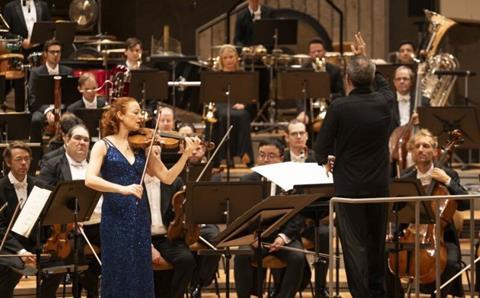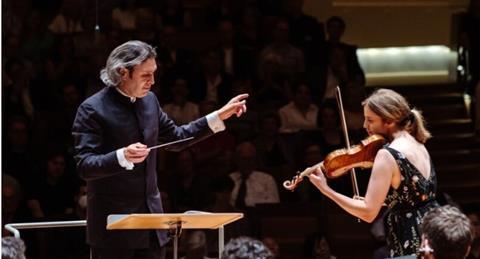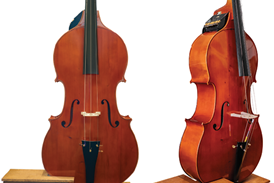Carlos María Solare hears some gems at the Berlin Philharmonie, as part of the capital’s annual festival

One of the city’s most prestigious musical events, Musikfest Berlin regularly provides a mouth-watering choice of artists and repertoire to kick-start the new season. Coincidentally, this year’s most interesting strings-related concerts happened within a few days of one another. Inspired by Alban Gerhardt’s ‘unique abilities’, Unsuk Chin’s Cello Concerto was seven years in the making; after its premiere at the 2009 Proms, it underwent two major revisions. Having first heard about the piece from its enthusiastic dedicatee, I was happy to catch up with it in a performance with Alisa Weilerstein and the Staatskapelle Berlin conducted by the soloist’s husband, Rafael Payare (8 September). Chin’s treatment of the cello – and of orchestral instruments in general – is highly personal, with playability not particularly high on her priority list. The result is an unusually wide tonal palette – the score lists 30 different percussion instruments – that the conductor was consistently successful in bringing out.
Watch: Alisa Weilerstein deconstructs the Prelude from Bach’s Cello Suite no.1 in G major
Read: Double Acts: Carolin and Jörg Widmann
Read: Vilde Frang on the mentors who steered her from talented teen to fully-fledged artist
From the start, when the solo line materialises out of the harps’ harmonics and goes on to undertake some unconventionally conceived chords and runs over four and more octaves, Weilerstein evinced a natural-sounding virtuosity, taking everything comfortably in her stride. Nonchalantly slapping the fingerboard, she easily solved some intricate double-stopping over a pedal point and was always eloquent in a piece that takes its inspiration from a Korean form of musical story-telling. Weilerstein fully lived up to this premise with emphatic parlando phrases, a kaleidoscopic vibrato and a tone that was by turns fragile and strongly determined. In her hands, Chin’s concerto was a musical adventure on a par with Mahler’s Fifth, which concluded the concert in a somewhat indulgent but exciting reading.
Just 24 hours later, the Berlin Philharmonic introduced its new artist-in-residence, Jörg Widmann, as conductor, composer and clarinet virtuoso. After Con brio, a short orchestral meditation on Beethoven’s music, there followed Widmann’s Second Violin Concerto, written in 2018 for his sister Carolin Widmann, who was also the soloist on this occasion. The piece’s first movement, called ‘Una ricerca’ (A search), occupies itself with various ways of bringing forth sound from the instrument: the soloist begins by bowing on the instrument’s waist, tonelessly passing over the strings. This quest continues throughout the following movements (‘Romance’ and ‘Mobile’), which eclectically touch upon very different sound worlds: Classical sequential phrases are clad in succulent Hollywoodesque harmonies, gently parodying the genre’s Romantic warhorses; there follows an interlude for percussion alone, while the concerto’s coda suggests a stylised can-can. Carolin Widmann, since childhood her brother’s adviser in all things strings, made a convincing case for the piece, realising its maverick instrumental effects with an enthusiasm that occasionally made one fear for her Guadagnini’s integrity. I couldn’t help wondering whether Widmann was aware of Paul Hindemith’s notorious marking, ‘beauty of tone is of secondary importance’; even in the work’s more obviously melodious sections, this ingredient was in conspicuously short supply.

I was reminded of the soloist’s string-crossing entry in the Widmann when Vilde Frang began Alban Berg’s Violin Concerto two days later on the same stage. The four-note motif evolved seamlessly from open strings to stopped 5ths thanks to Frang’s careful gauging of tonal intensity and vibrato. Under Vladimir Jurowski’s careful watch, she was very much a prima inter pares, the Bavarian State Orchestra’s principals to the fore from the first, prominent double bass solo onwards. The second movement’s canonic cadenza was played in its ossia version involving two solo violas, who duly got a round of applause at the end. The score’s suggestion of a vanished ideal world was well caught by Frang’s evocatively veiled sound, which grew into ringing vibrancy when appropriate. The stylised Ländler were idiomatically realised by the Munich musicians, who with Frang gave the concluding Bach chorale a cathartic quality. The orchestra, which this year celebrates its 500th anniversary, concluded the concert with an overwhelming performance of An Alpine Symphony. In a typically thoughtful gesture, Jurowski began the programme with the Third Symphony by Ukrainian composer Victoria Polevá, which mirrored Strauss’s work through its contemplation of nature in sound.
CARLOS MARÍA SOLARE
Reference









































No comments yet